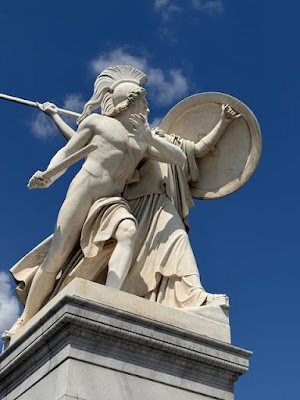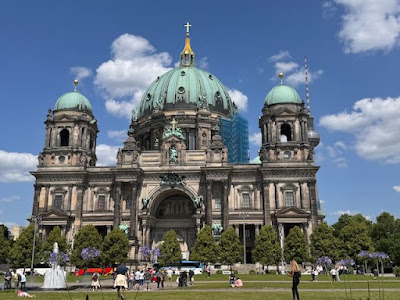The third and final "Must See in Berlin" on OFD's list was the Berlin Cathedral, which required another train ride and offered a glimpse of some magnificent nearby buildings.
sculptures along the bridge to Museum Island
Berlin Cathedral
Berlin Cathedral, also known as the Evangelical Supreme Parish and Collegiate Church, is a monumental German Protestant church and dynastic tomb at the Lustgarten on the Museum Island in central Berlin. ~ Wikipedia
The Berlin Cathedral was built during the reign of Kaiser Wilhelmina II during the years 1894 to 1905. A smaller baroque cathedral had previously stood on the same site.*
The Cathedral congregation has been in existence since 1608. The Cathedral includes three churches: the main church, the baptism and marriage chapel, and the memorial church (crypt).*
In May 1944 a firebomb hit the dome and damaged the building severely. The dome burned down and as it collapsed it destroyed a large part of the interior and the tombs.*
In the following years the damage was only provisionally repaired. In 1975 the rebuilding of the cathedral began in earnest. The memorial church was torn down. The baptism and marriage chapel was reopened in 1980.*
In 1993, after 18 years of construction work, the main church was rededicated. By 2002, the last of the reconstructed dome mosaics was revealed.*
The organ from the Wilhelm Sauer manufacturer is regarded as the largest and most important intact instrument with pneumatic action from the German Late Romantic Period.*
This organ, with its 7269 pipes, 113 stops, and four manuals, possesses an incredibly broad sound palette, so that it can create all kinds of musical shadings.*
The three windows in the altar area represent the birth, crucifixion and resurrection of Jesus. The oval windows contain angels representing faith, love and hope.
The altar, made of white marble and yellow onyx, is a creation of Friedrich August Stüler. Behind the white altar is The Apostles' Screen, by Karl Friedrich Schinkel, which is made of gilded bronze. The two ceremonial candle holders made of gilded iron were created by Karl Friedrich Schlinkel (as was the Apostles' Screen).*
The pulpit, on the far left, is made of carved oak following the sketch by Otto Raschdorff, the son of the Cathedral construction chief.*
* Information taken from the Berlin Dom pamphlet.
ceiling over the altar area
Ceremonial sarcophagus of Sophia Charlotte of Hanover
wife of Friedrich I
(1668-1705)
by Andreas Schlüter
Golden ceremonial sarcophagus of Friedrich I of Prussia
(1657-1713)
by Andreas Schlüter
Altes Museum
OFD made a quick trip inside the museum while Hubby and I looked for a couple of geocaches in the Lustgarten, the park on Museum Island.
reconstructed Berlin Palace
Formerly known as the Royal Palace, it was the main residence of the Electors of Brandenburg, Kings of Prussia and German Emperors from 1443 to 1918. The original palace was destroyed in WWII. Completed in 2020, the palace now houses the Humboldt Forum museum. ~ Wikipedia
a copy of East Gate of the Great Stupa of Sanchi in India
at the Berlin Palace & Humbolt Forum
We boarded our private NCL train, along with other NCL tour groups who spent the day off the ship, for a two-hour ride (less train traffic on the tracks) back to the port city of Warnemunde. It was light enough at 9 PM to find and sign the geocache near the port for another German state souvenir.






















No comments:
Post a Comment
Thanks for your comments!